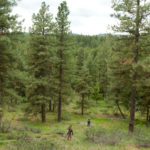Maintaining Healthy Forests Takes More than Planting Trees
Posted: August 15, 2016Source: Cool Green Science
What can we do to slow climate change and restore America’s forests? I used to think the answer was to plant more trees. Boom. Done. Mic drop.
But wait, that’s not the whole story.

Foresters plan for a healthy mix of spatial diversity in the L.T. Murray Wildlife Area. Photo © The Nature Conservancy (HannahLetinich)
Our remaining forests face great challenges like massive wildfires and invasive forest pests. Managing for this array of threats in a changing climate is complicated. Forest managers are researching strategies that can keep forests resilient under multiple stressors so that they can continue to provide habitat for wildlife, clean air, clean water, carbon storage, and, yes, timber far into the future.
Old-growth forests have stood for centuries, surviving the same kinds of challenges that forests face today. That’s why today’s forestry specialists, including scientists at the Nature Conservancy and the University of Washington are looking to them for clues to manage the dry fire prone forests of eastern Washington and Oregon, through which fires once naturally swept every 10-20 years.
They call it an old-growth forest, but not all of the trees are old. Through natural processes like disease and fire over time some trees die leaving openings where young trees have a chance to grow. In some places, perhaps because of soil conditions or past fire events there are large clearings. A healthy forest is a diverse mix of young and old trees, dead trees, and openings. Spatial diversity (in addition to biodiversity and genetic diversity) increases the resilience of the forest.
How can scientists, land managers, and foresters recreate this seemingly random mix of conditions in forests that have been altered by fire suppression, logging, and where natural forests have been transformed into plantations with evenly spaced stands of uniformly aged seedlings?
Enter science and the power of statistics.
Looking at satellite images and historical aerial photos of old-growth forests for reference, researchers found that forests were made up of a mosaic of individual trees, clumps, and openings (ICO). Working with dry fire prone forests, researchers quantified the average number of individual trees, clumps, and the area of openings statistically likely to be found over one hectare in a given climate. These natural references provide guideposts for the “ICO” (individuals – clumps – openings) approach to determining which trees to remove and which trees to leave during ecological restoration thinning projects.
The need for this type of ecological restoration thinning in the dry forests of western North America is great. For example, across eastern Oregon and Washington, a study led by Ryan Haugo of the Nature Conservancy in Washington found that 41% of forests in the region are currently too dense compared to reference conditions and would benefit from the removal of some trees by fire or mechanical means, including logging.
Patterns vary from region to region and even from watershed to watershed. However, once they’ve been calculated for an area, managers have a goal to work toward and a benchmark to measure success.
The ICO approach to restoration thinning works best in even-aged forests — often those that were replanted by people in the past (whether after logging or fire). Since these forests are often dense compared to natural reference conditions, the focus of management is on tree removal whether by fire or mechanical thinning. Once openings are created, trees will seed on their own and young trees will grow in naturally where conditions permit, so tree planting is not typically part of the management recommendation.
Wait, Why Can’t Forests Recover Without Intervention?
In 1994, the South Canyon Wildfire swept through Colorado killing 14 firefighters and scorching 2,115 acres. While South Canyon was relatively small in size compared to recent wildfires, it was a turning point for the forestry community. People realized that something was out of whack.
Hundreds of years of logging and replanting (in evenly spaced stands of the same aged trees), good management for maximizing timber production, had created homogenous forests, with few remaining large (i.e. more likely to survive a fire) trees or natural openings that might slow or stop a fire. On top of that, a hundred years of fire suppression left dense underbrush — fuel for a high-intensity fire (one that burns half or more of the forest canopy and everything on the forest floor).
Many of our forests remain homogenous and overgrown and, while there is lingering disagreement on how to restore diversity and resilience, forestry scientists agree that something needs to change.
Without management, these forests will remain prone to high-intensity wildfires and increased damage from forest pests. Events that threaten people, release large amounts of carbon into the atmosphere, have the potential to cost hundreds of millions of dollars, and from which some species of trees and areas of the forest may never recover.
The goal of the ICO approach is not to perfectly recreate the forests of the past, but to recreate the varied conditions that allow old-growth forests to survive and thrive for long periods of time. Some trees will die in prescribed fires or through removal, but a healthier forest will remain.

